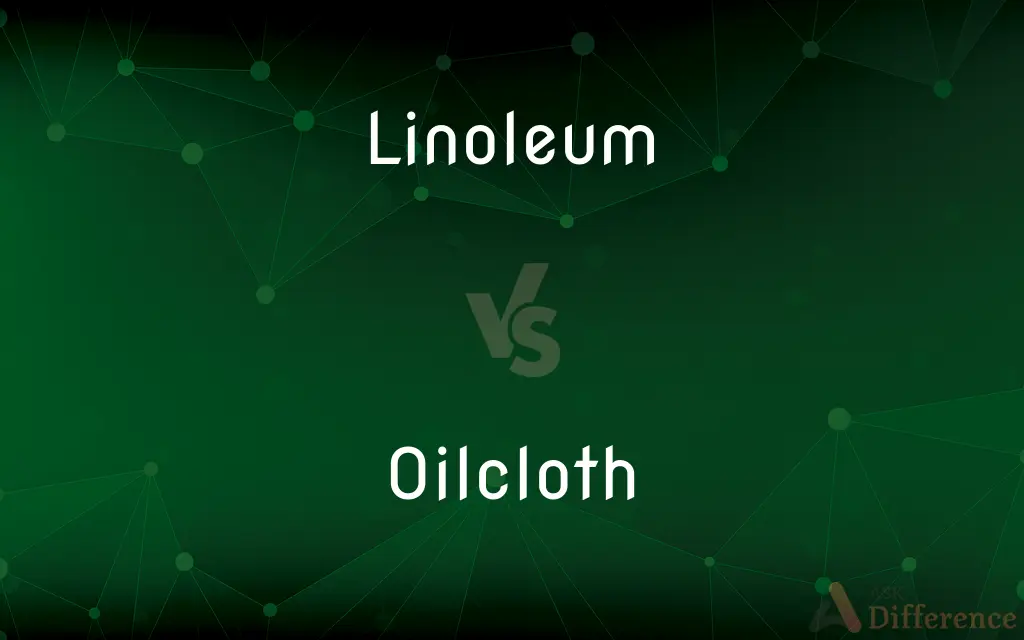Linoleum vs. Oilcloth — What's the Difference?
By Fiza Rafique & Maham Liaqat — Updated on April 9, 2024
Linoleum, a durable flooring made from natural materials, offers an eco-friendly option, whereas oilcloth features a waterproof, plastic-coated fabric, ideal for tablecloths and crafts.

Difference Between Linoleum and Oilcloth
Table of Contents
ADVERTISEMENT
Key Differences
Linoleum is a flooring material known for its durability and sustainability, made from natural ingredients like linseed oil, cork dust, and wood flour. This composition makes it an eco-friendly choice for homes and businesses seeking green alternatives. On the other hand, oilcloth refers to a fabric treated with oil or a synthetic compound to create a waterproof surface, commonly used for tablecloths, shelf liners, and various crafts. While both materials are used for covering surfaces, their composition and applications differ significantly.
Historically, linoleum was invented in the 19th century and gained popularity for its resilience and ease of cleaning, making it a common choice for kitchen and bathroom floors. Oilcloth, meanwhile, has roots going back further, initially made by coating canvas with linseed oil to create a waterproof material for sails and tarps, evolving into the brightly colored, vinyl-coated fabric seen today. While linoleum serves primarily as a flooring option, oilcloth is versatile in its usage, extending beyond flooring to decorative and functional items in households.
The manufacturing process of linoleum involves pressing a mixture of materials onto a jute backing, followed by a curing process that can take several weeks, enhancing its durability and creating its unique pattern through the material itself. Conversely, oilcloth is produced by applying a PVC coating to a cotton or linen base, making it instantly waterproof and ready for immediate use. This difference in production reflects in the texture and feel of each material, with linoleum being firmer and oilcloth softer and more flexible.
In terms of environmental impact, linoleum stands out as a more sustainable and biodegradable option, as it is made from renewable resources and does not emit harmful VOCs (Volatile Organic Compounds). Oilcloth, while practical for its water resistance and easy cleaning, is less environmentally friendly due to its plastic content and the process involved in its manufacture. However, its durability and ease of maintenance make it a popular choice for areas where moisture is a concern.
When considering cost and installation, linoleum can be more expensive initially and requires professional installation to ensure longevity and performance. Oilcloth, in contrast, is more affordable and can be easily cut and shaped by consumers for various DIY projects, making it a budget-friendly and convenient option for quick updates around the home or for craft activities.
ADVERTISEMENT
Comparison Chart
Composition
Natural materials (linseed oil, cork)
Plastic-coated fabric
Primary Use
Flooring
Tablecloths, crafts
Durability
Highly durable, suitable for floors
Water-resistant, durable for its uses
Environmental Impact
Eco-friendly, biodegradable
Less eco-friendly due to plastic
Installation and Cost
More expensive, requires professional installation
Affordable, easy DIY installation
Compare with Definitions
Linoleum
Made from Natural Ingredients.
Linoleum's composition includes linseed oil, contributing to its eco-friendly profile.
Oilcloth
Versatile in Usage.
Oilcloth is often used in DIY projects due to its ease of handling and durability.
Linoleum
Durable Flooring Material.
Many homeowners choose linoleum for their kitchens due to its long-lasting nature.
Oilcloth
Brightly Colored Designs.
The kitchen shelf looks vibrant lined with brightly colored oilcloth.
Linoleum
Eco-friendly Choice.
Opting for linoleum flooring is a step towards sustainable living.
Oilcloth
Less Environmentally Friendly.
Despite its practicality, oilcloth's plastic composition makes it less green than some alternatives.
Linoleum
Requires Professional Installation.
Installing linoleum flooring typically necessitates hiring a professional to ensure it is done correctly.
Oilcloth
Waterproof Surface.
Oilcloth tablecloths are popular for outdoor tables because they repel water.
Linoleum
Historically Popular.
Linoleum was once the go-to choice for kitchen and bathroom floors in many homes.
Oilcloth
Affordable and Easy to Handle.
Making a custom oilcloth tablecloth is an affordable way to brighten up a dining area.
Linoleum
Linoleum, commonly shortened to lino, is a floor covering made from materials such as solidified linseed oil (linoxyn), pine resin, ground cork dust, sawdust, and mineral fillers such as calcium carbonate, most commonly on a burlap or canvas backing. Pigments are often added to the materials to create the desired colour finish.
Oilcloth
Oilcloth, also known as enameled cloth or American cloth, is close-woven cotton duck or linen cloth with a coating of boiled linseed oil to make it waterproof.
Linoleum
A material consisting of a canvas backing thickly coated with a preparation of linseed oil and powdered cork, used especially as a floor covering.
Oilcloth
A heavy cotton fabric treated with linseed oil and pigments to make it waterproof.
Linoleum
A durable, washable material made in sheets by pressing a mixture of heated linseed oil, rosin, powdered cork, and pigments onto a burlap or canvas backing. Linoleum is used as a covering especially for floors.
Oilcloth
A waterproof material made up of a layer of vinyl and a layer of cotton or a synthetic fabric.
Linoleum
An inexpensive waterproof covering used especially for floors, made from solidified linseed oil over a burlap or canvas backing, or from its modern replacement, polyvinyl chloride.
Oilcloth
A fabric or cloth treated on one side with a waterproof covering, especially one made from linseed oil etc.; used for flooring, tablecloths, kitchen shelves and sometimes furniture covering.
Linoleum
Linseed oil brought to various degrees of hardness by some oxidizing process, as by exposure to heated air, or by treatment with chloride of sulphur. In this condition it is used for many of the purposes to which India rubber has been applied.
Oilcloth
Cloth rendered waterproof by treatment with oil or paint, and used for marking garments, covering tables, shelves, floors, etc.
Linoleum
A kind of floor cloth made by laying hardened linseed oil mixed with ground cork on a canvas backing.
Oilcloth
Cloth treated on one side with a drying oil or synthetic resin
Linoleum
A floor covering
Common Curiosities
Can oilcloth be used outdoors?
Yes, oilcloth is suitable for outdoor use due to its waterproof properties.
How do you clean oilcloth?
Oilcloth can be wiped clean with a damp cloth, making maintenance simple and quick.
Can linoleum be recycled?
Linoleum is biodegradable and can be recycled, contributing to its eco-friendly status.
What are common uses for oilcloth?
Oilcloth is commonly used for tablecloths, shelf liners, and various crafting projects.
Does linoleum require special care?
Linoleum flooring should be cleaned with specific products designed for its material to maintain its appearance and longevity.
Is linoleum environmentally friendly?
Yes, linoleum is considered eco-friendly due to its natural composition and biodegradability.
How is oilcloth made?
Oilcloth is made by coating a fabric base with PVC to make it waterproof.
Can linoleum be used in any room?
Yes, linoleum can be used in any room, though it is particularly popular in kitchens and bathrooms due to its resilience and ease of cleaning.
Is linoleum expensive?
Linoleum can be more costly than some other flooring options, but its durability and eco-friendly qualities often justify the price.
What is linoleum made of?
Linoleum is made from natural materials like linseed oil, cork dust, wood flour, and jute.
Is oilcloth durable?
Yes, oilcloth is durable and resistant to water and stains, making it a long-lasting choice for many applications.
How long does linoleum flooring last?
With proper care, linoleum flooring can last up to 40 years.
What's the difference between linoleum and vinyl?
Linoleum is made from natural materials and is biodegradable, while vinyl is synthetic and not eco-friendly.
Why choose oilcloth over other materials?
Oilcloth is chosen for its waterproof qualities, easy maintenance, and the vibrant designs available, making it ideal for both practical and decorative uses.
Can oilcloth be sewn?
Yes, oilcloth can be sewn, making it a popular choice for homemade bags and aprons.
Share Your Discovery

Previous Comparison
Array vs. Variety
Next Comparison
Row vs. SailAuthor Spotlight
Written by
Fiza RafiqueFiza Rafique is a skilled content writer at AskDifference.com, where she meticulously refines and enhances written pieces. Drawing from her vast editorial expertise, Fiza ensures clarity, accuracy, and precision in every article. Passionate about language, she continually seeks to elevate the quality of content for readers worldwide.
Co-written by
Maham Liaqat














































